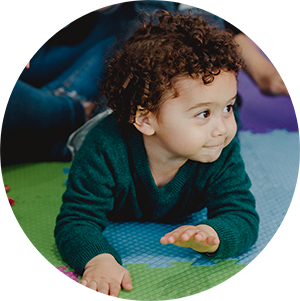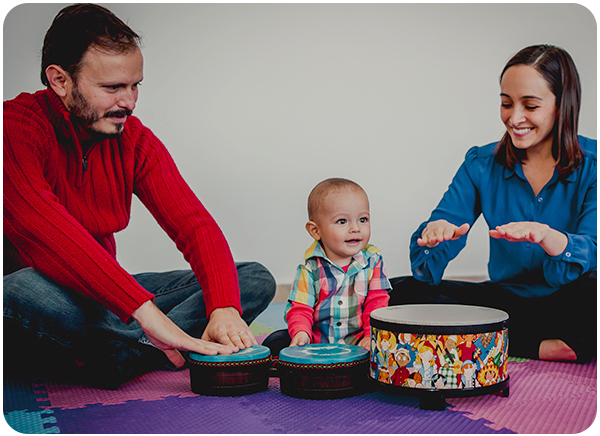Teaching the Way Children Learn
 If you peek into a Music Together class, you might see children crawling across the circle, wandering around, or simply sitting and staring. You might wonder how the grownups can be so engaged when it looks like the children aren’t learning anything.
If you peek into a Music Together class, you might see children crawling across the circle, wandering around, or simply sitting and staring. You might wonder how the grownups can be so engaged when it looks like the children aren’t learning anything.
Here’s the not-so-secret secret: Young children learn differently than their parents and caregivers. What might look like disinterest in adults is often a natural part of a child’s learning process. Our little ones learn instinctively and constantly, absorbing the world through all their senses.
 They learn through immersion, interaction, and by imitating and playing with what they observe in their own way, in their own time—as we see when a toddler who wanders around during class hums a tune in the car ride home or a three-year-old who watches carefully for 45 minutes excitedly leads a music class for their stuffed animals later that day!
They learn through immersion, interaction, and by imitating and playing with what they observe in their own way, in their own time—as we see when a toddler who wanders around during class hums a tune in the car ride home or a three-year-old who watches carefully for 45 minutes excitedly leads a music class for their stuffed animals later that day!
As teachers, parents, and caregivers, we can support children’s music-learning by letting them participate in music class however they would like, instead of encouraging them to change their behavior so it looks more like traditional learning. Instead of suggesting they “Clap like the teacher,” or “Stay in the circle,” allow them the freedom to experience the class in whatever way feels right to them.
What might look like chaos to the uninitiated is called “developmentally appropriate practice” in educator-speak. This child-centered approach to teaching is at the core of all Music Together curricula. Kenneth K. Guilmartin, Music Together Founder/Artistic Director, describes the concept behind developmentally appropriate practice and how he and Music Together coauthor Dr. Lili M. Levinowitz applied it to the Music Together teaching approach:
Early in my teaching career, I realized the most effective approach for working with the very young is to be goal-supportive rather than goal-directed. Music Together teachers learn to reinforce spontaneous music behaviors that we know support development, but they don’t directly instruct or require these behaviors from the children.
Music Together teachers learn how to observe their students and then use what they are doing in class. When they see that a child is tapping sticks to a song, they might suggest, “Let’s all tap like Jake today!” Or, if a baby starts singing, “Aaah,” the teacher may lead the class singing a verse on that vowel sound. By reflecting back to the child, we validate their behavior and encourage more experimentation.
You can do it at home, too. Think about this: We naturally copy children’s babbling sounds in order to support their language development. When we echo back children’s music-play in the same way, this serve-and-return activity supports their music-learning. We’re essentially reinforcing their first attempts at music-making!
Music Together teachers are trained to look out for music behaviors in class. They can point out tonal and rhythm expressions that don’t necessarily look like singing and dancing in the traditional sense. And they can help parents learn to playfully support their child’s music development over time, both in class and at home. If you ever have any questions about music behaviors you see in your child, feel free to ask your teacher and check out the Growth Chart you received in class.
Most importantly, keep having fun making music with your wandering, wiggling, watching little one. Your encouragement will help them grow into the confident music-maker they were born to be.




